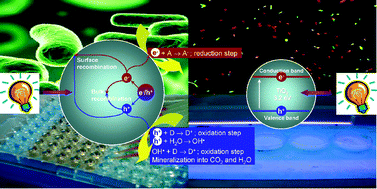Numeration methods for targeting photoactive materials in the UV-A photocatalytic removal of microorganisms
Abstract
This tutorial review reports on the different numeration methods for evaluating the efficiency of the photocatalytic action on microorganisms. Here we put forward the advantages and drawbacks of the standard methods such as the plate count, the fluorescence techniques and the Most Probable Number method for determining the biocidal photocatalytic activity and thus selecting efficient photocatalytic materials among complex systems. We highlight that bacterial spores are a representative and suitable tool for meeting the restrictive requirements resulting from the complex use of living matter instead of chemical targets.


 Please wait while we load your content...
Please wait while we load your content...